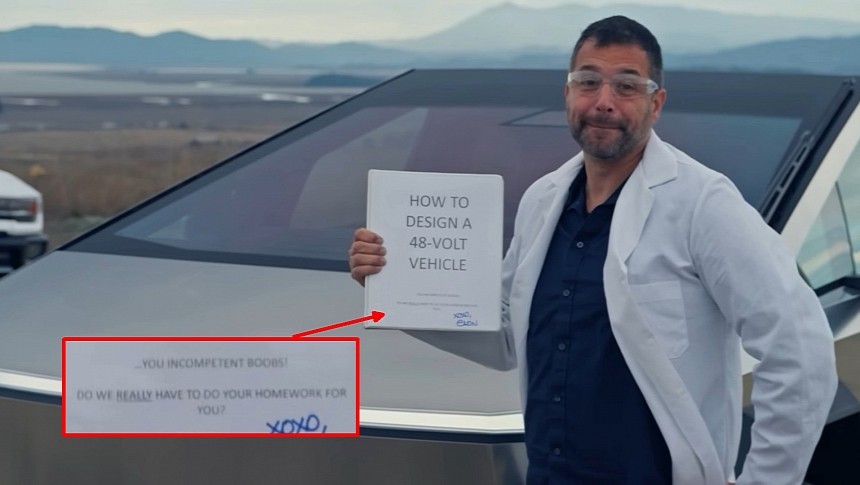Tesla seems serious about changing the automotive industry forever, not least by offering its latest technologies for free. In the latest move, Tesla sent the documentation of the Cybertruck's 48-volt architecture to other carmakers. Ford CEO Jim Farley confirmed he got a copy and thanked Elon Musk for it.
Tesla has embarked on a journey to change the automotive industry, and this goes further than just flooding the market with electric vehicles. Sure, Tesla proved to everyone that electric cars can be desirable, affordable, and even profitable. But it also started innovating like there's no tomorrow, leaving legacy carmakers frozen in the past. Metaphorically, you can compare Tesla to a young athlete, while traditional automakers are like old men barely dragging their feet.
Tesla's declared mission is to advance electrification in order to save the Earth. To achieve that, Tesla is willing to work with its competitors. This is why it offered most of its patents for free to anyone who agreed not to sue Tesla for patent infringement. This is not exactly similar to open-sourcing them, as Tesla claims, but it's close enough. More recently, Tesla onboarded industry leaders to advance the technologies that made sense for it, like the NACS adoption.
Tesla can afford to do that, being the dominant player in the EV arena. Other carmakers also have little to lose, considering how far behind they are with electrification. It's a win-win, which Tesla exploited with the standardization of its NACS plug. The EV market leader is again pushing boundaries in attempting to impose the 48-volt architecture as the new automotive standard.
The last time such a leap occurred was between the 1950s and 1970s when the automotive industry abandoned the 6-volt electrical circuits in favor of the more powerful 12-volt architecture. With modern vehicles using components that draw more power from the battery, there was also a push for a 42-volt auxiliary system in the late 1990s. However, the plans have been canceled after hybrid vehicles and the use of high-voltage starter/generators have eased the burden on the 12-volt electrical system.
Tesla announced switching to a 48-volt architecture with the Cybertruck about a year ago, and it delivered on that claim. The Cybertruck doesn't even have 12-volt outlets and it uses 110-volt house outlets instead. The use of a 48-volt low-voltage architecture requires changing everything that needs power in the vehicle, from blowers to actuators to safety equipment. Producing these in small quantities is costly, and it's understandable why Tesla wants the whole industry to adopt the higher-voltage architecture.
This is why Elon Musk announced that he would send the 48-volt architecture documentation to other carmakers to adopt. This was another "All Our Patent Are Belong To You" move, although not everyone believed it did happen. In the Cybertruck video review, Hagerty's Jason Cammisa held a paper titled "How to design a 48-volt vehicle." The page also had a tongue-in-cheek subheader reading, "...you incompetent boobs! Do we have to do your homework for you?"
Despite looking like a Cammisa joke, Musk did send the 48-volt architecture documentation to industry leaders. On Wednesday, Ford CEO Jim Farley confirmed on X that he received the whitepaper dated December 5, four days after the video was published. Farley confirmed that the paper he received looked nothing like the one in the video, at least as far as the cover page was concerned.
It remains to be seen whether having this documentation would entice other carmakers to adopt the 48-volt electrical system. This could help reduce wiring thickness, saving costs and limiting losses, but it also needs new components. Having four 12-volt lead batteries is a big no in a modern vehicle, so Li-ion cells will need to be used for the low-voltage battery. Even the move from 6 volts to 12 volts took the industry more than two decades, let's hope that boosting the voltage four times will not take twice as long.
Tesla's declared mission is to advance electrification in order to save the Earth. To achieve that, Tesla is willing to work with its competitors. This is why it offered most of its patents for free to anyone who agreed not to sue Tesla for patent infringement. This is not exactly similar to open-sourcing them, as Tesla claims, but it's close enough. More recently, Tesla onboarded industry leaders to advance the technologies that made sense for it, like the NACS adoption.
Tesla can afford to do that, being the dominant player in the EV arena. Other carmakers also have little to lose, considering how far behind they are with electrification. It's a win-win, which Tesla exploited with the standardization of its NACS plug. The EV market leader is again pushing boundaries in attempting to impose the 48-volt architecture as the new automotive standard.
The last time such a leap occurred was between the 1950s and 1970s when the automotive industry abandoned the 6-volt electrical circuits in favor of the more powerful 12-volt architecture. With modern vehicles using components that draw more power from the battery, there was also a push for a 42-volt auxiliary system in the late 1990s. However, the plans have been canceled after hybrid vehicles and the use of high-voltage starter/generators have eased the burden on the 12-volt electrical system.
This is why Elon Musk announced that he would send the 48-volt architecture documentation to other carmakers to adopt. This was another "All Our Patent Are Belong To You" move, although not everyone believed it did happen. In the Cybertruck video review, Hagerty's Jason Cammisa held a paper titled "How to design a 48-volt vehicle." The page also had a tongue-in-cheek subheader reading, "...you incompetent boobs! Do we have to do your homework for you?"
Despite looking like a Cammisa joke, Musk did send the 48-volt architecture documentation to industry leaders. On Wednesday, Ford CEO Jim Farley confirmed on X that he received the whitepaper dated December 5, four days after the video was published. Farley confirmed that the paper he received looked nothing like the one in the video, at least as far as the cover page was concerned.
It remains to be seen whether having this documentation would entice other carmakers to adopt the 48-volt electrical system. This could help reduce wiring thickness, saving costs and limiting losses, but it also needs new components. Having four 12-volt lead batteries is a big no in a modern vehicle, so Li-ion cells will need to be used for the low-voltage battery. Even the move from 6 volts to 12 volts took the industry more than two decades, let's hope that boosting the voltage four times will not take twice as long.
They weren't joking. We received the document today, dated Dec. 5th. Thanks, @ElonMusk. Great for the industry! https://t.co/DkLaHA84CY
— Jim Farley (@jimfarley98) December 7, 2023









